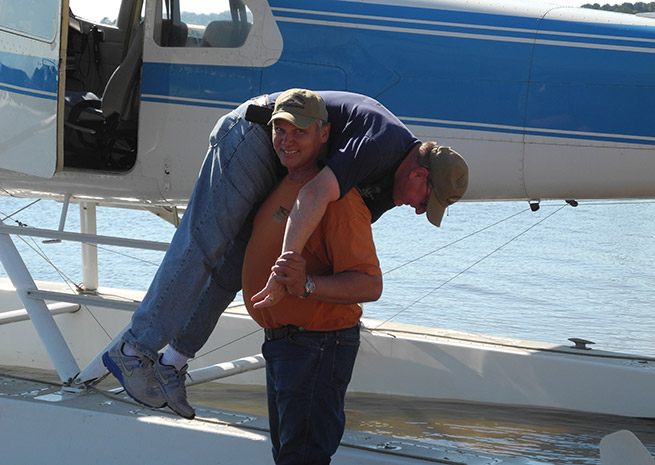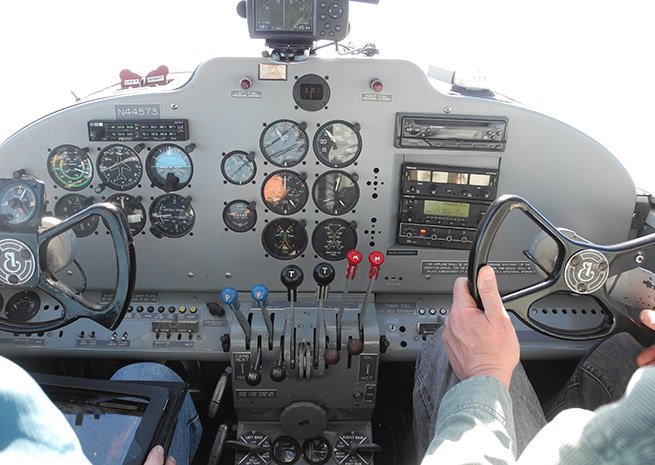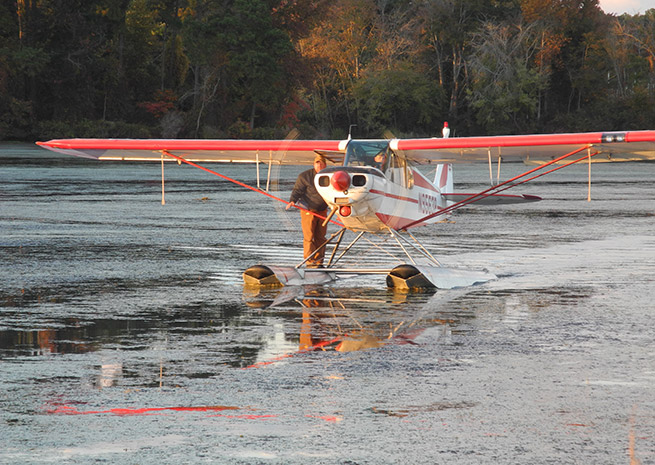Weekend seaplane odyssey
Three days, five seaplanes, 13 pilots, and 1,200 nm
The spectacle of our gaggle of beached seaplanes becomes evident when a local fellow walks up, mouth agape, points, and says with a thick Alabama drawl, “What is that?”
That is a Beech 18 on straight floats, and, yes, it alone is quite an unusual sight on Eufaula Lake in southern Alabama. In fact, because only about six are flying, it’s quite a sight anywhere.
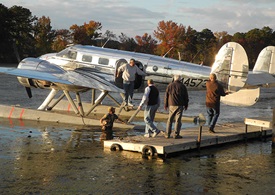
The 1944 radial-engine twin along with the other four seaplanes definitely has the attention of the few families picnicking and fishing along the shore on this warm, sunny autumn Sunday. Most have never seen a floatplane before, and certainly not one—or five—on this remote corner of their lake.
Five of us pile out of the old Beech 18, shoes off, pant legs rolled up, wading the last few feet to shore. I hand Nikali Pontecorvo (let’s just call him “Nick”) the anchor from the aft cabin and he shoves it in the sand while I tighten the line, keeping the 18 from drifting into the Cessna 180 on floats backed in next to us. Nick wades out, pops open the float compartment and begins unloading red plastic gas cans, hands them to me, and I hoist them up on the wing to AOPA President and CEO Mark Baker, owner of this polished aluminum gem. He hands them over the top to Greg Herrick, who begins pouring the 100LL into the softball-sized filler port on the right wing.

It takes a village to keep this 70-year-old flying.
Meanwhile, beside us, the pilots and passengers of the Cessna 180, Piper Super Cub, and Cessna 172 perform similar feats, although at a lesser scale than the lumbering Beech demands. Herrick adds oil to the big Pratt & Whitney radials by the gallon, after all.
One from our cohort, flying a Cessna 182 on amphibious floats, has landed at an airport of all places, to get his fuel; conveniently pumped out of a truck, no doubt. The rest of us, all on straight floats, don’t have that luxury.
A cooler is dragged from the 18, sandwiches get made on the beach, and we take a break from our trek from cool and drizzly Minnesota to sunny Florida where the seaplanes are headed for the winter.
The caravan started two days earlier when we left Minneapolis, flying low over the Mississippi River to Le Claire, Iowa.
An 'explorer's notebook'
As we motor by, coveys of migrating coots and ducks form massive patches on the river, which looks like a north/south seam in the fabric of landscape. Barges long as a city block trudge up and down the massive waterway, seemingly hemmed in on each side by busy railroads and highways. Like stitches in the landscape, bridges span the river, linking Minnesota and Wisconsin, Illinois and Iowa. River town after river town passes our wing tips, streets lined with trees in full autumn glory. With names like Winona, La Crosse, Dubuque, and Clinton, it’s like we’re flying through an early explorer’s notebook. Not a ripple of turbulence disturbs our airborne perch.
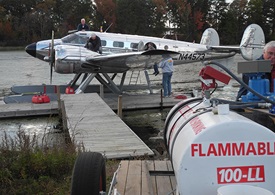
Just north of Moline and Davenport, Baker spots the dock at Le Claire and sets up for a fly by for the waiting media and townsfolk. Down river, he cranks the 18 around and heads north, expertly splashing the airplane onto the river, slowly taxiing up to the dock where Brian Schanche, pilot of the Cessna 180, is there to grab a rope from Herrick, who has stepped out on the float.
The other airplanes trickle in and line up along the dock as suitcases and gear empty from the airplanes. The two local TV reporters grab a sound bite from Schanche, the organizer of the seaplane migration. He owns Adventure Seaplanes, which trains seaplane pilots out of Surfside Seaplane Base near Minneapolis in the summer and out of Cherry Pocket on Lake Pearce south of Orlando in the winter. Schanche has done this trip before, but usually with just two or three airplanes. Our gaggle of five, especially with the classic Beech, amps up the dock appeal and, with 14 people involved, the logistics. Three of his airplanes are flying with CFIs in the right seat and seaplane students in the left, gaining valuable cross-country seaplane experience. Once in Florida, they will take their checkrides.
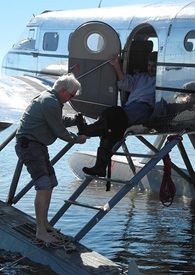
Longtime seaplane pilot and friend of Schanche George Millar and his wife Jody host us in Le Claire, where that evening we and the airplanes are the talk of the town.
Millar has rigged up a fuel tank on a trailer to fuel our fleet, and the next morning under bright blue skies we trundle off the water, headed southeast. The colorful leaves turn more rust colored as we progress, dropping into Green Turtle Marina at Grand Rivers, Ky., just south of Paducah, for another fuel stop.
The requirement to land on water—and water where you have a hope of finding fuel—definitely makes flight planning a challenge when flying cross country in airplanes with straight floats. The advantage of amphibious floats becomes obvious.
The red gas cans are dragged out of the float compartments and we’re soon hoisting fuel up and over the polished wings on the Beech 18.
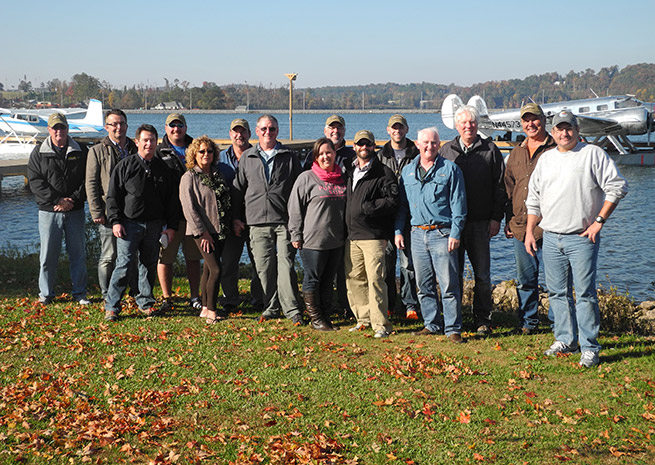
Soon, Alabama’s Guntersville Lake scrolls into view, and with much coaching from Baker, I plunk the 18 onto the water, powering up for long taxi to an actual seaplane dock, which is located right off the end of the runway at Joe Starnes Field. Once again, a crowd awaits, delighted to see the airplanes on the sparkling lake under a golden sunset.
Airport manager Matt Metcalfe dons chest waders to help secure the flotilla. Metcalfe, the winner of an AOPA Flight Training Scholarship in 2012, is managing the airport’s runway expansion project. An ATV pulls up, tugging a fuel tank on a trailer and the fueling begins again as the crowd watches. Sensing a future seaplane pilot, Baker asks Metcalfe if he wants a ride in the 18. He doesn’t have to ask twice, and away they go.
The next morning, we set sights for Eufaula Lake in southern Alabama, our final fuel stop before hitting Schanche’s place in Florida.

A hasty tailwind pushes us over flat Florida and I replay the last couple of days of flying in my head. While the seaplanes bring a whole new dimension to flying, what’s the same are the people and small intersections between them in aviation. Thomas Walter, a German pilot for Lufthansa, is piloting his Cessna 182 on amphibious floats, making the trip simply because he enjoys the people he’s gotten to know through Schanche. With him are Colleen and James Roberts, who answered an ad he placed to simply fill the seats on the trip. James Roberts is considering buying a 182 on floats to use in the Northwest and Alaska, so it was a chance to get some time in one. When stepping out of the office at Surfside before the trip started, they ran into Nick—owner of Key West Seaplanes. Nick flew up from Key West, just for the chance to get some stick time in the Beech 18 and to hang with his friends Herrick, Baker, and Schanche. But James and Colleen quickly recognize Nick as the pilot who flew them to a remote Key West island where they got married on the beach Dec. 12, 2012. In aviation, it seems like about two degrees of separation, not six.
We make a low pass down the runway at Fantasy of Flight just west of Orlando. Owner Kermit Weeks is standing on the wing of an airplane as we buzz by. He’s friends with Baker and Herrick, who, like Weeks, is a collector of classic and antique airplanes.
In no time, we’re set up for final on Lake Pearce, where Nick brings the 18 down to the water. We all peer outside, looking for one of the thousands of alligators that supposedly call the lake home—not a place to find yourself suddenly in the water.
We taxi up to the dock at Schanche’s Florida operation, ending our seaplane odyssey, but only beginning relationships with newfound friends.



